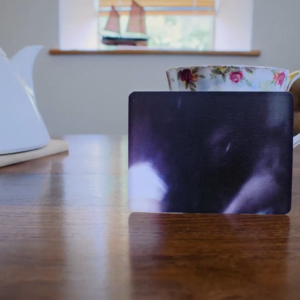Sala Equis
La memoria de los otros. Recuerdo, familia y archivo
15.09.2024. 16h
Artistas: Enrique Ramirez (chi), Tess Martin (hol), Thales Pessoa (bra) y Tsai Yu Ting (tw)
Al igual que los rasgos circulan por la memoria genética y se heredan a través de generaciones, la memoria familiar se basta de cualquier detalle para reavivar su razón de ser. Un álbum de fotografías, una postal sobre la que se acumula el polvo, la cinta de vídeo que se reproduce en un televisor; un gesto aprendido, otro gesto heredado; el vacío que ocupa el silencio y el sonido de un familiar querido… Todo ello, además del tema del recuerdo, el de los círculos familiares y el entorno político que los circunda recorren las cuatro obras presentadas en el marco de PROYECTOR, en su edición de 2024, para la sala equis de Madrid.
En un momento concreto de la pieza 1976: Search for Life (2023) de la artista holandesa Tess Martin, la cámara se acerca con cierta cautela a una televisión analógica que emite las imágenes del módulo de aterrizaje Viking de la NASA sobre la superficie de marte. Una voz en off explica al espectador imaginario (el de los 70 y el contemporáneo) el objetivo principal de la misión: encontrar vida en la superficie terrestre del planeta rojo. No obstante, añade una segunda cláusula: entender la evolución del pasado para predecir lo que ocurrirá en el futuro. El mismo pretexto es el que lleva a Martin a explorar el viaje de un padre primerizo por carreteras escocesas, tierra natal de su madre, junto a su mujer y su bebé. La voz de la narradora devuelve a la vida las palabras inscritas en el diario del padre, año 76, a medida que una serie de postales de archivo se inmiscuyen e interrumpen las imágenes de parajes fijos en una suerte de presente continuo. El objetivo: interrogar el pasado familiar para comprender lo acontecido.
Por su parte, la revelación de la memoria a partir de un juego de espejos metanarrativo es el motivo principal de Maternal bond (2023). Tsai Yu Ting recurre a la conversación entre tres generaciones, la abuela, la madre y el nieto, para explorar los fallos del recuerdo enquistado que sólo se reaviva mediante la máscara y la invención (la máscara del croma verde, de la recreación de la fotografía familiar y del maquillaje y de los parecidos). Maternal bond se concibe como una exploración de los vínculos y de la memoria de los rasgos físicos que encarnan los detalles nimios de la piel. El lápiz sobre el rabillo del ojo, la profundidad de la expresión de la mirada, el arqueo impasible de una ceja o la mueca pálida de una tímida sonrisa revelan parecidos que compilan a las distintas generaciones sobre una memoria común.
En otro sentido, el fino y sutil paso de lo privado a lo público, del recuerdo a la historia y de la memoria filial a otro tipo de memoria familiar recorren las calles de la ciudad a través tanto de la mirada de Thales Pessoa como de la de Enrique Ramírez. En el primer caso, Pessoa cruza en Forastero (2022) los testimonios de tres desconocidos que deambulan en la noche. Sus historias, cargadas de vivencias que debaten sobre la violencia, adquieren su sentido al entreverarse entre el anonimato de la ciudad. En el segundo, Brises (2008), de Enrique Ramírez, se plantea un recorrido secuencial a través de lo familiar entendido como cercano, semejante o propio. El caminar lento de un cuerpo casi automatizado que pasea por las avenidas de Santiago de Chile encarna la dicotomía que encierra el vagar en una dirección concreta. Esto es, recuperar la memoria política de la dictadura, asentada sobre edificios emblemáticos como el Palacio de la Moneda o la Plaza de la Ciudadanía, al tiempo que las vallas que dificultan su acceso nos hablan de la propia materialización de su olvido.
Texto: Luis Cemillán Casis
The memory of others. Remembrance, family and archive
Just as traits circulate through genetic memory and are inherited through generations, family memory uses any detail to revive its raison d’être. An album of photographs, a postcard on which dust accumulates, a videotape played on a television set; a gesture learned, another gesture inherited; the emptiness occupied by the silence and the sound of a beloved relative… All this, in addition to the theme of memory, that of family circles and the political environment that surrounds them, are present in the four works presented in the framework of PROYECTOR, in its 2024 edition, for the Sala Equis in Madrid.
At a specific moment in the piece 1976: Search for Life (2023) by the Dutch artist Tess Martin, the camera approaches with a certain caution an analogue television that broadcasts the images of NASA’s Viking lander on the surface of Mars. A voiceover explains to the imaginary viewer (1970s and contemporary) the main objective of the mission: to find life on the surface of the red planet. However, it adds a second clause: to understand the evolution of the past in order to predict what will happen in the future. It is the same pretext that leads Martin to explore the journey of a first-time father on Scottish roads, the homeland of his son’s father. The narrator’s voice brings back to life the words inscribed in her father’s diary, year 76, as a series of archive postcards intrude and interrupt the images of fixed places in a sort of continuous present. The aim: to interrogate the family past in order to understand what has happened.
For its part, the revelation of memory through a meta-narrative mirror game is the main motif of Maternal bond (2023). Tsai Yu Ting uses the conversation between three generations, grandmother, mother and grandson, to explore the failures of a festering memory that is only revived through mask and invention (the mask of the green chroma, of the recreation of the family photograph and of make-up and resemblances). Maternal bond is conceived as an exploration of the bonds and memory of the physical features embodied in the minute details of the skin. The pencil in the corner of the eye, the depth of the expression of the gaze, the impassive arch of an eyebrow or the pale grimace of a shy smile reveal resemblances that bring together different generations on a common memory.
In another sense, the fine and subtle passage from the private to the public, from memory to history and from filial memory to another kind of family memory, run through the streets of the city through the gaze of both Thales Pessoa and Enrique Ramírez. In the first case, Pessoa crosses in Forastero (2022) the testimonies of three strangers who wander through the night. Their stories, full of experiences that discuss violence, acquire meaning as they interweave in the anonymity of the city.
In the second, Brises (2008), by Enrique Ramírez, a sequential journey is proposed through the familiar understood as close, similar or one’s own. The slow walking of an almost automated body that strolls along the avenues of Santiago de Chile embodies the dichotomy of wandering in a specific direction. That is, recovering the political memory of the dictatorship, settled on emblematic buildings such as the Palacio de la Moneda or the Plaza de la Ciudadanía, at the same time as the fences that hinder its access speak to us of the very materialisation of its oblivion.
Text: Luis Cemillán Casis










